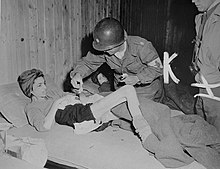Penig subcamp
The satellite camp Penig near present-day Peniger district Langenleuba-Oberhain was from January 1945 until April 1945. existing satellite camp of Buchenwald concentration camp for at least 700 female concentration camp prisoners (January 1945). The prisoners had to do forced labor at the Max-Gehre-Werke, which supplied the Junkers aircraft and engine factories .
Structure and function of the camp and prisoners
The Penig subcamp was built at the end of 1944 on behalf of Max-Gehre-Werke as a fenced barrack camp on the site of a former gravel pit. In January 1945, 700 Hungarian Jewish women from the Ravensbrück concentration camp were transferred to the newly established camp, where they arrived on January 10, 1945. Many of these women arrived at the camp exhausted and sick. The women had to march three kilometers a day to the Max-Gehre-Werke and produce aircraft parts there seven days a week in three shifts without breaks.
There were no spare clothes or washing facilities in the camp. The inadequate hygienic storage conditions combined with an inadequate food supply led to increasing exhaustion and illness among the women. In addition to typhoid and tuberculosis , the women suffered from pneumonia , furunculosis and gangrene . While the average sick leave in January 1945 was 36, it rose to 96 by March 1945. The sick were transferred to the infirmary or the terminally ill to the so-called “cripple barracks”. At times there was no medical care and sufficient medication, bandages, etc. were not available in the warehouse. Until the Penig subcamp was closed, at least ten prisoners died as a result of inhumane working conditions, lack of food or illness.
Warehouse staff
The command leader in the Penig satellite camp was Josef Ebenhöh, to whom 26 SS men and 18 female guards were subordinate. As far as is known, no member of the security guards had to answer in court because the accused could not be identified.
Liberation of the camp
The satellite camp was cleared around April 13, 1945; a few days earlier an "evacuation transport" with a hundred female prisoners had arrived at the satellite camp from Abteroda . The women had to go on a death march and were only released in Leitmeritz after the guards had left. 34 women ran to Theresienstadt . In the “cripple barracks” of the subcamp, around 80 seriously ill, exhausted and unable to march women were left without care . They were liberated on April 15, 1945 by soldiers of the 6th US Armored Division of the US Army . As a result of the inhumane storage conditions and the inadequate care, some women died in a hospital despite immediate medical care.
The conditions after the liberation were filmed by two soldiers of the United States Army Signal Corps . These recordings are a sequence in the documentary Nazi Concentration Camps .
The former camp site is a memorial, nothing in Penig itself reminds of the former satellite camp.
literature
- Irmgard Seidel: Penig subcamp . In: Wolfgang Benz , Barbara Distel (eds.): The place of terror . History of the National Socialist Concentration Camps. Volume 3: Sachsenhausen, Buchenwald. CH Beck, Munich 2006, ISBN 3-406-52963-1 .
Web links
- "Nazi Concentration Camps" at archive.org - recordings of the liberated camp from 5.20 min
Individual evidence
- ↑ a b c d Irmgard Seidel: Penig satellite camp . In: Wolfgang Benz, Barbara Distel (eds.): The place of terror: History of the National Socialist concentration camps , Volume 3: Sachsenhausen, Buchenwald . Beck, Munich 2006, pp. 544f
Coordinates: 50 ° 57 ′ 19.5 " N , 12 ° 40 ′ 6.9" E


